





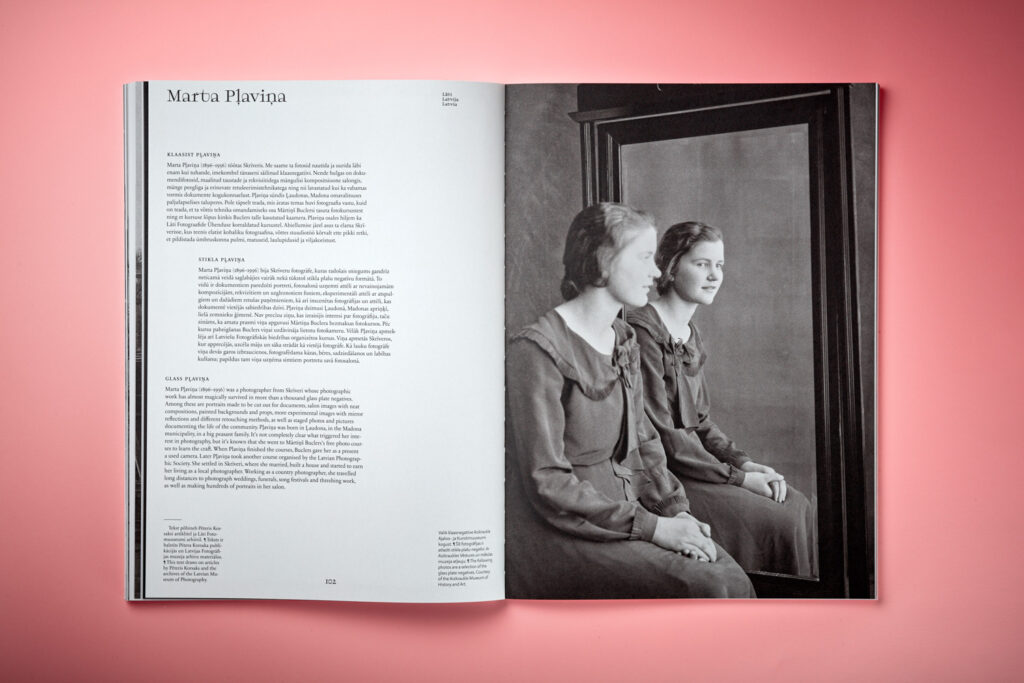

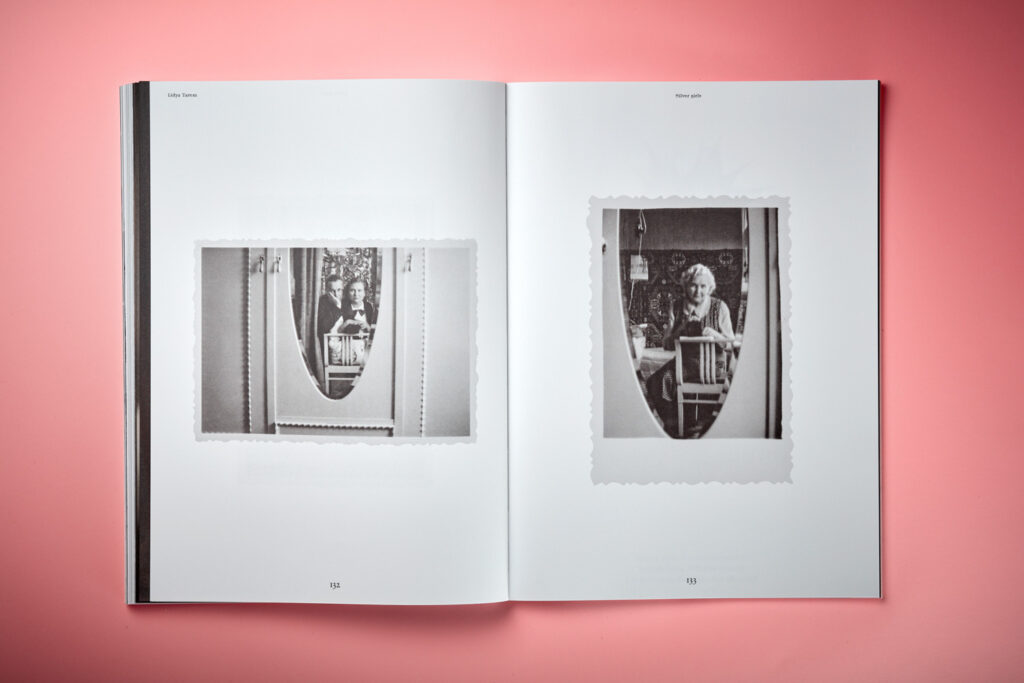








Toimetajad / Editors: Šelda Puķīte, Indrek Grigor
Kujundus / Graphic design: Alexey Murashko
Väljaandja / Publisher: Tartu Kunstimuuseum / Blind Carbon Copy 2020
Pehmed kaaned / Soft cover
Keeled / Languages: Eesti, Latviski & English
Lehekülgi / Pages: 176
Testimonials:
Interviews with Evita Goze, Alise Tifentale and Agnė Narušytė:
Näitus
Tartu Kunstimuuseumis
12.06.2020—27.09.2020
Exhibition
at Taru Art Museum
12.06.2020—27.09.2020

Näitust „Hõbetüdrukud. Fotograafia retušeeritud ajalugu” tutvustas kümmet Eesti ja Läti varajast naisfotograafi kõrvuti kolme tänase Euroopa kunstnikuga, kes uurivad meie visuaalse ajaloo kadunud ja unarusse jäetud tahke.
The exhibition “Silver Girls. Retouched History of Photography” introduced a selection of works by ten early women photographers from Estonia and Latvia and placed them in the company of three contemporary European artists who contemplate the lost and the neglected in our visual history.
Üldiselt arvatakse, et fotograafia dokumenteerib reaalset maailma. Samuti usutakse, et arhiivid ja ajaloolised kollektsioonid koondavad objektiivseid tõsiasju. Lähemal uurimisel aga selgub, et arhiive on kogutud ja hiljem ajaloolaste poolt uuritud kindlatel eesmärgil. Nõnda on ka fotod alati tehtud teatud vaatepunktist ning parandatud autori või vaataja maitsemeele kohaselt.
Photography is commonly believed to document the world as it is. Similarly, archives and historical collections are believed to represent imagined universal truths. On closer inspection, however, it turns out that archives are collected and later investigated by historians with a particular goal in mind. In a similar manner, photos are always taken from a particular angle and are enhanced to please the author or the viewer.
Fotograafia on olnud naiste hulgas populaarne alates selle algusaegadest ning mitte ainult hobina, vaid ka erialana. Sarnaselt paljude teiste valdkondade ja erialadega on aga ajalooraamatutest raske naisfotograafide jälgi leida. See näib eriti iroonilisena, kui arvestada, et fotostuudiotes töötasid retušeerijatena peamiselt naised, kes oma tööga vormisid vaatajate kujutluspilti maailmast.
Photography has been popular among women since its early days, not just as a hobby but as a profession. In common with many other fields and professions, in history books women photographers are hard to find. This seems especially ironic as the retouchers working in photo studios were mostly women shaping images of the world to please others.
Näitus „Hõbetüdrukud” tutvustab kümmet varajast naisfotograafi, kes töötasid Eesti ja Läti aladel, ning lisab neile kolm tänapäevast Euroopa kunstnikku, kes uurivad meie visuaalse ajaloo kadunud ja unarusse jäetud tahke. Baltikum proovib terves maailmas üha tuure koguvale naisajaloouurimisele järele jõuda ning koondada ka oma pärandikilde, et taasleida kadunud lugusid. Mõned neist lugudest on kunstiajalooliselt märkimisväärsed peatükid, mõned aga väikesed, kuid sisukad täiendused meie ühisele ajalooteadmisele.
The exhibition “Silver Girls” introduces a selection of works by ten early woman photographers who worked in the area of Estonia and Latvia and places them in the company of three contemporary European artists who contemplate the lost and the neglected in our visual history. As the research into women in history expands worldwide, the Baltic states are catching up and putting together pieces that have been preserved to clarify women’s stories and their legacies. Some of the stories turn out to be very significant in the context of art history, and some serve as small but important expansions of an already existing view of our common past.
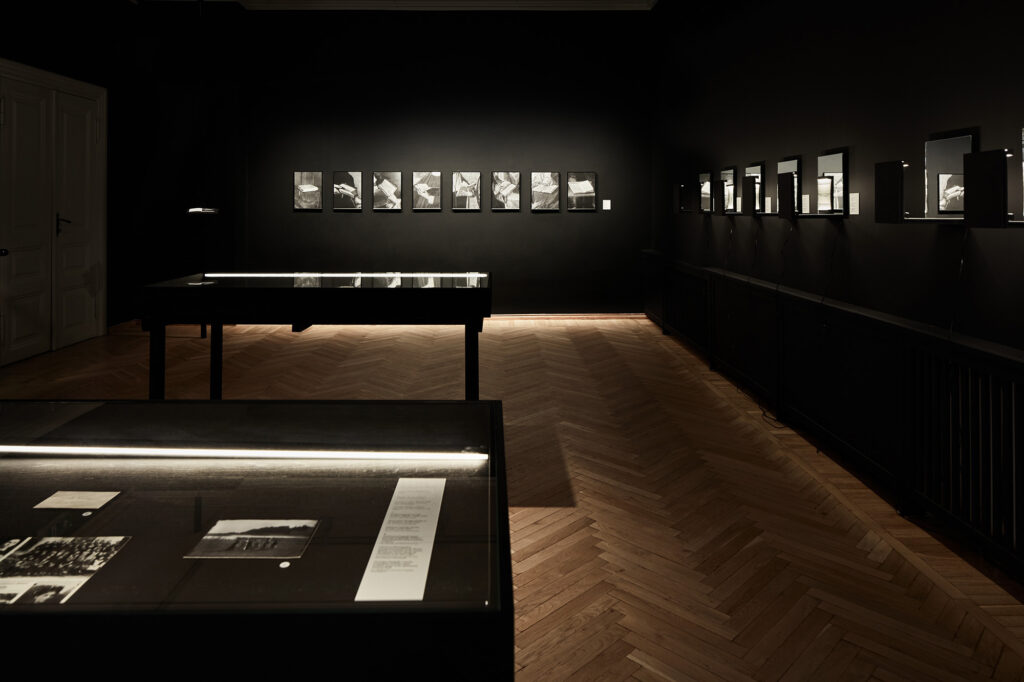






Foto / Photos: Alexey Murashko
Et kaotatu, leitu ja ümberjutustatu vaagimisel uusi vaatenurki avada, oleme palunud näitusel osalema ka kolm tänapäevast kunstnikku, kes räägivad oma lugusid pikalt peidus olnud ajaloolistest hetkedest ja isikutest. Ajaloo mõistatused koosnevad kaotatust ja leitust, hävinust ja taasavastatust ning keelatust ja lubatust. Need moodustavad meie ajalooteadmise, mis on aga tegelikult lihtsalt see peegel, millesse oleme otsustanud vaadata. „Hõbetüdrukud“ pakub võimaluse näha ajalugu läbi füüsilise ja metafoorse tõepeegli.
As the research continues, we offer a glance at these stories through the surface of another physical and metaphorical reflector of truth – the mirror – which has played a significant role in making the photographic image itself. To enhance the contemplation of the lost and found and retold we have chosen three contemporary artists to tell their stories about certain moments and people in history, from the photo reproductions of destroyed artworks and films to historically important people whose legacies have been overlooked and therefore have long been hidden. History is made out of puzzles of the lost and found, the destroyed and recovered, the denied and accepted, making our present history just a certain type of mirror we choose to look into.


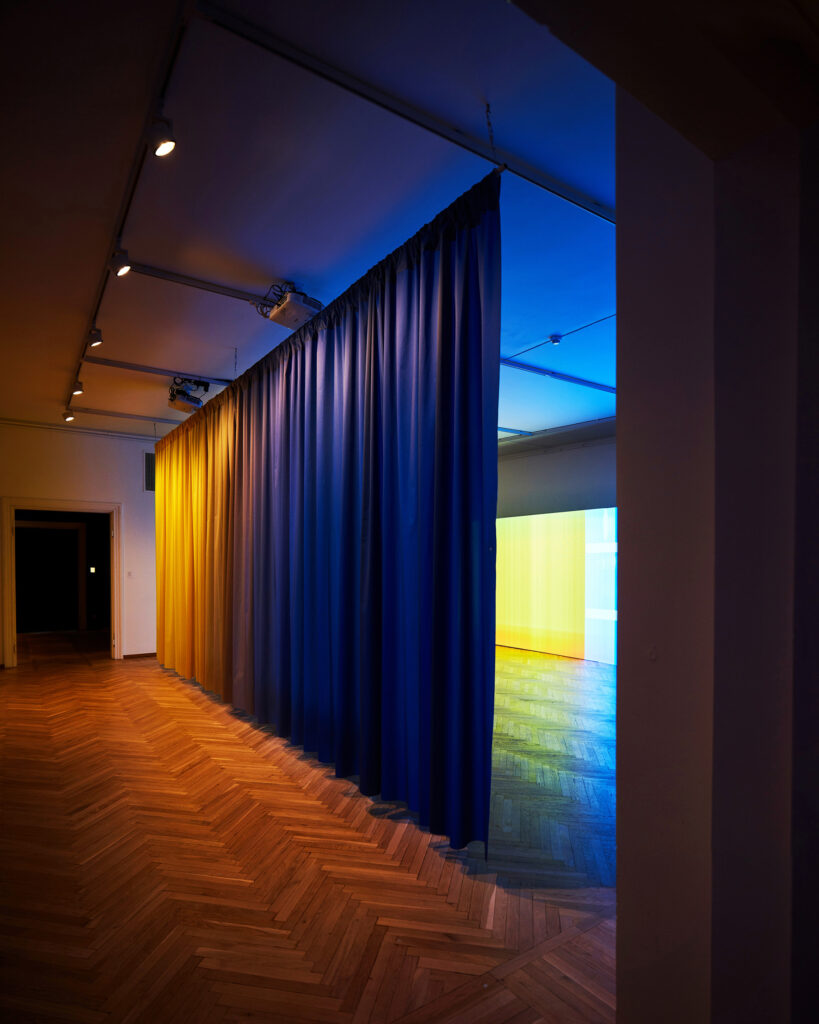

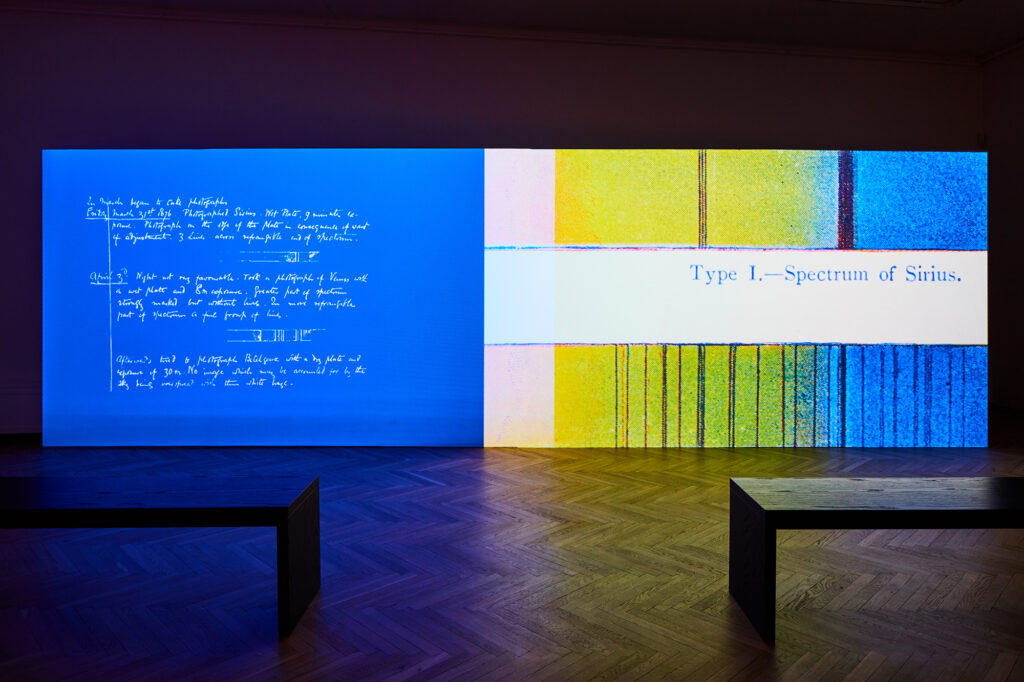


Foto / Photos: Alexey Murashko
Tartu Kunstimuuseum kui mäluasutus püüab olla teadlik oma rollist avalikkust teeniva ajalooliste teadmiste koguna. Viimane sunnib meid aga pidevalt kaaluma, mida ja kuidas me ajaloost teame. Sellest eesmärgist lähtus hiljutine kunstikooli Pallas pärandit taastutvustav näitus ning see oli muuhulgas tõukeks näitustesarjale „Tartu 88“, mille eesmärgiks on olnud viimaste kümnendite kunstiloos haigutavate lünkade tuvastamine ja täitmine. Sajanditagusesse ajalukku vaatav näitus „Hõbetüdrukud”, mille tähtautoriteks on varased naisfotograafid, peaks samuti panustama ühe kunstiloolise lünga täitmisse, sedakorda läbi rahvusvahelise haardega väljapaneku.
The Tartu Art Museum as a memory institution is aware of its role as a collection of public knowledge: a position which inevitably brings with it the need to constantly reconsider what we think we know about the past and the ways we understand it. This was the curatorial position of the recent exhibition on the Pallas Art School and has been the impetus for the exhibition series Tartu 88, which was initiated to determine and fill the gaps in our knowledge of recent art history. The exhibition “Silver Girls. Retouched History of Photography” sheds light on another such blind spot via an international exhibition.
Kuraatorid / Curated by: Šelda Puķīte ja Indrek Grigor
Läti varajased naisfotograafid / Early Women Photographers from Latvia: Antonija Heniņa (1897–1979), Minna Kaktiņa (1876–1949), Lūcija Alutis-Kreicberga (1889–1985), Emīlija Mergupe (1885–1972) ja Marta Pļaviņa (1896–1956).
Eesti varajased naisfotograafid / Early Women Photographers from Estonia: Olga Dietze (19. sajandi teine pool – 20. sajandi esimene pool), Helene Fendt (1896–?), Anna Kukk (1885–1979), Hilja Riet (1905–2006) ja Lydia Tarem (1904–1979).
Kaasaegsed kunstnikud / Contemporary participants: Nanna Debois Buhl, Sami van Ingen, Elisabeth Tonnard
Kujundaja / Designer: Alexey Murashko
Koordinaator / Co-ordinator: Kristlyn Liier
Toetajad / Supported by: Eesti Kultuurkapital, Nordic Culture Point, Frame Contemporary Art Finland, Soome Instituut Eestis, Läti Kultuurkapital
Koostööpartnerid / In collaboration with: Fotomuuseum, Viljandi Muuseum, SA Hiiumaa Muuseumid, Rīgas vēstures un kuģniecības muzejs, Latvijas Fotogrāfijas muzejs, Aizkraukles Vēstures un mākslas muzejs, Rīgas Fotogrāfijas biennāle 2020, Pēteris Korsaks, Kristjan Riet
Sümpoosion
Fotograafia retušeerimata ajalugu
Symposium
Unretouched History of Photography

14. augustil 2020 toimus Tartu Kunstimuuseumis sümpoosion „Hõbetüdrukud. Fotograafia retušeerimata ajalugu”.
Sarnaselt näitusega oli sellega kaasnenud sümpoosionil kaks lähtepunkti. Esiteks varajased naisfotograafid Balti riikides, teiseks ikka ja jälle kinnitust leidev kultuurilooline fenomen, mille ainsaks järelduseks saab olla, et kunst on igavene. Teosed kui füüsilised objektid võivad küll hävida: unarusse jäetult laguneda, tulekahjus ära põleda või sihiteadliku lõhkumise ohvriks langeda. Ent lähemal vaatlusel selgub, et hävinud teosed ei ole laiemast kultuuriruumist siiski kuskile kadunud ja avaldavad meile kõigest hoolimata jätkuvalt mõju. Neid reprodutseeritakse raamatutes, neist räägitakse konverentsidel ning need on endiselt kohal näitustel. Käsikirjad ei põle ning nii jäävad arhiivid nagu meediumid spiritualistlikul seansil tulevikust tagasi pöörduma, et leida kadunuke, kellega kõnelda.
The symposium Unretouched History of Photography was held on the 14th of August 2020 at the Tartu Art Museum in conjunction with the exhibition Silver Girls. Retouched History of Photography.
The Exhibition Silver Girls features ten early women photographers from the geographical region of Latvia and Estonia. However, rather than a historical overview, the exhibition cherishes the role that the lost and forgotten heritage plays in culture.
The symposium also has two points of focus: one being early female photographers in the Baltic region and the other the cultural phenomena that make art indestructible. Works of art can be physically destroyed – burned or just neglected to the point of total deterioration – but they still continue to influence our current culture. Not only that: as absurd as it may sound, they will feature in exhibitions and in books. Manuscripts don’t burn and thus, like ghosts, archives will continue to come back from the future to find somebody to talk to.
Katrīna Teivāne-Korpa PhD
The Phantom Female Photographers in the History of Latvian Photography
The common way to research the history of photography in the first part of the 20th century is through periodicals, usually issued by photographic societies, and exhibition catalogues. This allows us to follow historical records, main ideas and, of course, to spotlight personalities considered to be significant in the field. Another and definitely most important way how to learn this history is by researching the actual photographic archives. But what are they? In her presentation Katrīna Teivāne-Korpa will draw attention to the problems emerging in the research process and will point out how the presence of female photographers or photographic workers can be traced.
Katrīna Teivāne-Korpa is an art historian focusing her research on early Latvian photography. She holds a PhD from the Art Academy of Latvia with her thesis The Development of Art Photography in Latvia and the Legacy of Roberts Johansons (1877–1959). In her everyday job she is working as the head of the Konrāds Ubāns Art Reading Room at the National Library of Latvia.
Mari Vallikivi MA
Four Women and a Man: Half a Century of Photography in Viljandi
One of the most important pre World War II photo salons in Estonia was situated in Viljandi. Owned by Jaan Riet, the salon and its story would be unthinkable without four women: Jaan Riet’s wife Marie Riet, her sister Anna Kukk, and two daughters who were born and raised in the studio, Hilja and Elma Riet.
Mari Vallikivi is an art historian and the head of Kondas Centre in Viljandi with expert knowledge of the city’s cultural history. Among numerous other exhibitions, she has curated an exhibition of Hilja Riet’s heritage.
Agnė Narušytė PhD
The Photo-Fiction of Veronika Šleivytė: A Rediscovered Archive
In the 1990s, Veronika Šleivytė (1906–1998), known only as a sentimental painter of flowers, left several suitcases filled with prints and negatives to a local museum. They proved to be a major discovery for the history of Lithuanian photography: in the 1930s, Šleivytė had participated in the movement of art photography, experimented, documented her own life with family and friends, including her lovers – all women. In 2020, a book Foto Vėros Šleivytės was published by the Kupiškis Ethnographic Museum. One of its editors, Agnė Narušytė will discuss this fascinating archive and how it was turned into a book.
Agnė Narušytė is a Lithuanian photography historian, critic and curator. She has worked as a curator at the Lithuanian Art Museum, taught at Edinburgh Napier University, UK, edited the foreign culture page for the cultural weekly 7 meno dienos, Vilnius, and created programmes on culture for the Lithuanian National Television. She is the author of the book The Aesthetics of Boredom in Lithuanian Photography.
Sümpoosioni toetasid / Supported by: Eesti Kultuurkapital ja Soome Instituut.
Täname / Special thanks to: Paavo Mardi, Elektriteater ja Rīgas vēstures un kuģniecības muzejs


